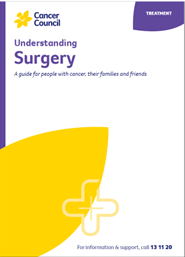- Home
- Breast cancer
- Treatment
- Surgery
- Mastectomy
Mastectomy
Surgery to remove the whole breast is called a mastectomy. One breast may be removed (single or unilateral mastectomy) or both breasts (double or bilateral mastectomy).
When is a mastectomy recommended?
A mastectomy may be recommended if:
- there is cancer in more than one area of the breast
- the cancer is large compared with the size of the breast
- it is difficult to get a clear margin around the tumour
- you have inflammatory breast cancer
- you have had radiation therapy to the same breast before and so cannot have it again
- the cancer has come back or you have a new cancer in the same breast
- you have the BRCA1 or BRCA2 gene mutation.
You may prefer to have a mastectomy instead of breast-conserving surgery – even if you have a very small cancer. You will not usually have radiation therapy after a mastectomy, although it may be offered in some situations.
What are skin-sparing or nipple-sparing mastectomies?
The nipple is often removed in a mastectomy. In some cases, however, the surgeon may perform a skin-sparing or nipple-sparing mastectomy. This means that more of the normal skin (with or without the nipple) is kept. If you have decided to have a reconstruction, and can have a skin-sparing or nipple-sparing mastectomy, the reconstruction is sometimes done at the same time.
What are your options if you don’t have a reconstruction?
If you don’t have a reconstruction, you have the option of wearing a soft breast form with a specially designed bra while your surgical wound heals. Breast Cancer Network Australia (BCNA) provides a free bra and temporary soft form. Speak to your breast care nurse for more details. After the wound has healed and the area is comfortable, you have the option to be fitted for a permanent breast prosthesis.
What about the other breast?
If you need a mastectomy because of cancer in one breast, you may think it’s safer to have the other breast removed as well. For most people, the risk of getting cancer in the other breast is low.
If you have the BRCA1 or BRCA2 gene or another rare breast cancer gene mutation, this does increase the risk of developing another breast cancer, so you may choose to have a double mastectomy (bilateral mastectomy) to remove both breasts.
Whether to have a double mastectomy is a complex decision. It is best to talk with your treatment team about the risks and benefits before making a final decision.
→ READ MORE: Breast reconstruction
Podcast: Coping with a Cancer Diagnosis
Listen to more of our podcast for people affected by cancer
More resources
Dr Diana Adams, Medical Oncologist, Macarthur Cancer Therapy Centre, NSW; Prof Bruce Mann, Specialist Breast Surgeon and Director, Breast Cancer Services, The Royal Melbourne and The Royal Women’s Hospitals, VIC; Dr Shagun Aggarwal, Specialist Plastic and Reconstructive Surgeon, Prince of Wales, Sydney Children’s and Royal Hospital for Women, NSW; Andrea Concannon, consumer; Jenny Gilchrist, Nurse Practitioner Breast Oncology, Macquarie University Hospital, NSW; Monica Graham, 13 11 20 Consultant, Cancer Council WA; Natasha Keir, Nurse Practitioner Breast Oncology, GenesisCare, QLD; Dr Bronwyn Kennedy, Breast Physician, Chris O’Brien Lifehouse and Westmead Breast Cancer Institute, NSW; Lisa Montgomery, consumer; A/Prof Sanjay Warrier, Specialist Breast Surgeon, Chris O’Brien Lifehouse, NSW; Dr Janice Yeh, Radiation Oncologist, Peter MacCallum Cancer Centre, VIC.
View the Cancer Council NSW editorial policy.
View all publications or call 13 11 20 for free printed copies.

